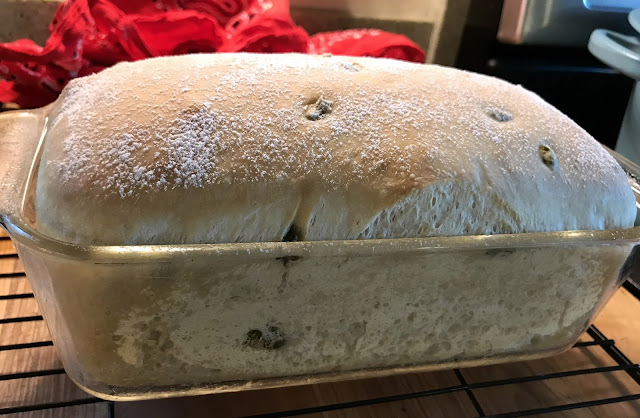 |
| Sourdough starter after overnight pre-ferment |
 |
| Sourdough dough after mixing in flour. Sticky but not liquid. |
Once I have a starter going, the starter itself is easily maintained in perpetuity. I keep it in a wide-mouth jar, in the refrigerator. I use about ¼ cup of this mother culture, each time I make a loaf. When it's down to about ½ cup volume, I mix in another 1 cup of flour and 1 cup of water, loosely cap the jar, let it sit for ½ day, tighten the cap and return to refrigerator. The details of timing and amount are not precise, and it doesn't matter. The culture is resilient and alive, and handles minor variations without objecting.
I start my dough as a pre-fermented starter, the evening before making a loaf. The timing is not precise. I usually start the pre-ferment in early evening, when I make supper, but have waited until bedtime without it causing any problems. It is a very low-input thing to do.
I mix together 1½ cup water and 1½ cup organic, unbleached bread flour. I use an old Pyrex 4-cup measuring cup as a bowl and cover with plastic wrap. Nothing else. I think the organic unbleached bread flour makes a better loaf than the alternative. Then let it sit overnight. In the morning, the starter is foamy and bubbly. There is some separation of water which is normal. There is some variation from time to time, probably due to kitchen temperature, but that does not matter. It smells sour, which is good.
The final loaf volume depends on the amount of water in the starter. I make a standard 8½ inch or 9 inch Pyrex bread pan loaf. The 1½ cup water translates into a loaf with a little extra that I make as a mini-loaf in a wide mouth glass canning jar. To leave out that mini-loaf, I would use 1¼ cup water and 1¼ cup flour for the original starter preferment.
In the morning, I use an old mixing bowl. I add 1½ cup flour and 1½ teaspoon salt. A lot of recipes call for more salt but that is too much for a healthy amount of dietary sodium. This amount rises well and also tastes very good.
It takes some muscle to mix in the flour. I gradually mix in enough so that the spatula will stand upright without falling over, but it is still very sticky. I don't turn it out onto a board and knead. This method results in a fully hydrated dough. Then I let it sit roughly an hour, and use the spatula to fold it several times, turning the bowl by hand and folding from every side. The consistency by that point is no longer sticky.
Later I'll post as the loaf develops. Sourdough is the ultimate "slow food". I think my loaves are delicious, filling, and make bread something to be excited about instead of that mushy cake-like stuff from the store. Plus, there is no added sugar, so they are healthier.
I often use whole wheat flour for the actual loaf, or add other additives to be described later. This description is for the basic white sourdough sandwich loaf.
<-------------------------o--------------------->
Sourdoughs are made around the world, from many types of milled wheat and rye flour, and using many methods. There are diverse types of bacteria and yeast that work together in sourdoughs. The bacteria and yeasts seem to come from the grain mill, where suitable organisms from the air survive and inoculate the grain and flour, but may also be in the kitchen and the baker's hands. Once established, a sourdough culture becomes resilient to introduction by other organisms, but may adapt to new regions and circumstances if the starter is taken to a new place.
Discover Magazine The Biology of Sourdough. and
The Sourdough Microflora. Biodiversity and Metabolic Interactions.
Probably most important,
Josey Baker's website and book. Baker is the source for enthusiasm, accessible artisanship, and the concept of a fully hydrated dough, which is different and better than what I did in the past. Even though I make sandwich loaf, and his are hearth style artisan loaf, my bread is better for reading his book and watching his videos.


















